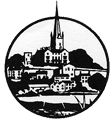Visit to Ragley Hall and Coughton Court (10th June 2015)
Twenty-five Society members (plus four from Cheltenham DFAS who responded to our invitation to join us to make up numbers) made the short journey to Alcester to visit the two historical houses close to the town.
Following refreshments on arrival at Ragley Hall, we split into two groups for first-rate, very detailed, guided tours of the principal rooms on the first floor, which were those for receiving and entertaining guests. Ragley, designed in 1680 by Dr. Robert Hooke (he of the scientific Law governing the compression of metal springs), remains in the private ownership and occupation of the Seymour family (now headed by the 9th Marquess of Hertford). The house, which now stands in a much-reduced (!) estate of just 6,500 acres, was not finally finished and furnished until the mid-late 18th Century, when the family's former house on an adjacent site immediately behind was pulled down. By then, James Gibbs had completed the exquisite baroque plasterwork in the Great Hall and certain other rooms. In 1680 Wyatt added an immense Portico, incorporating grand stone staircases to the first floor entrance to the Great Hall. He also installed subtly elegant plasterwork in various rooms.
There is a wealth of furniture, paintings and other fine art throughout the house, almost all dating back to the 18th Century and earlier. Notable exceptions are two modern works of art: a large painting on the massive North staircase by Ceri Richards in 1964 depicting - if it is carefully explained to one - The Defeat of the Spanish Armada; and a mural, The Temptation, set around the whole of the equally sturdy South staircase. This was painted by Graham Rust between 1969 and 1983, principally depicting elements of the family history, with great touches of sly humour and some iconic images.
The word "ragley" is Saxon for rubbish dump: Ragley Hall certainly isn't!
There was just enough time for a brisk walk around the large, colourful formal garden at the rear of the house before we moved on to the National Trust's Coughton Court for lunch and a brief introductory talk.
Coughton Court is something of a contrast to Ragley Hall - yes, it has a long-established family, the Throckmorton's, still in residence: 700 years down and still well over 200 still to go under the longest lease ever granted by the National Trust when the estate was donated soon after the Second World War - but it is much older and has only about a hundred acres of land left of an estate that once stretched for as far as the eye could see in all directions. A staunchly Catholic family and very much persecuted by, and after, Henry VIII, the Throckmortons were closely implicated not only in the Throckmorton Plot to murder Queen Elizabeth but also, indirectly, in the Gunpowder Plot - but they managed to survive these and their recusancy.
The house is largely 16th Century, though partially rebuilt following attack by a Protestant mob during the Civil War. There are many papers associated with the Gunpowder Plot on show, and a two-level priest's hole. There are two churches adjacent to the house: one originally Catholic but redenominated as Anglican, by decree; and one built once Catholicism was "allowed" again.
There are lakes and rivers in the grounds but the main feature is an award-winning garden designed by the daughter of the present family incumbent. This comprises many "rooms" and a plethora of flowers (especially roses) and shrubs that are all an English garden should be. There was plenty of time to explore the house, the churches and the gardens before boarding the coach for the journey back to Ross.
It was evident that all who came to visit these two country house gems were impressed and rewarded by what they experienced. Particular thanks are due to the Cheltenham contingent, who did more than just make up the numbers.
Philip Blunden

